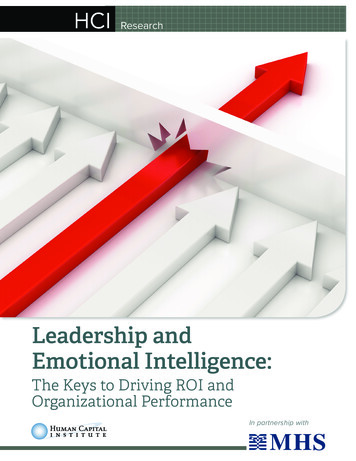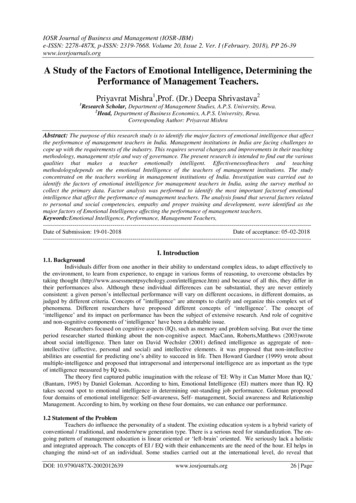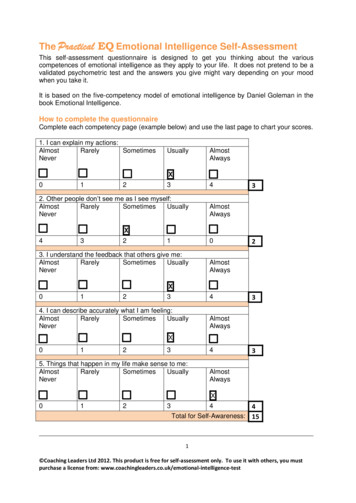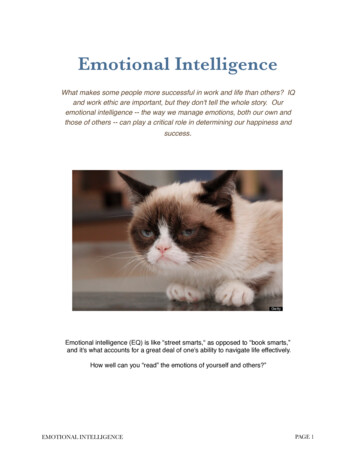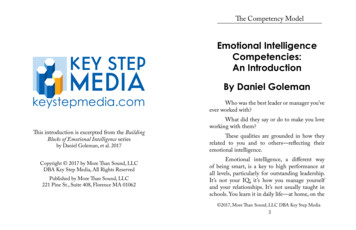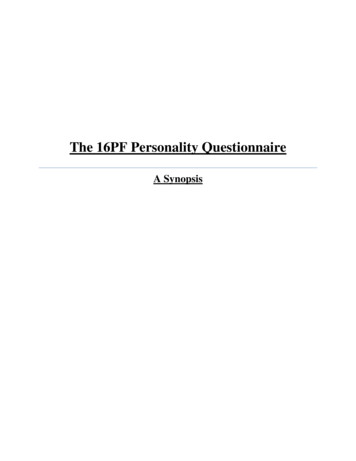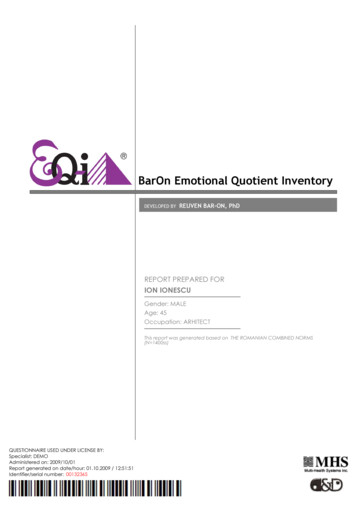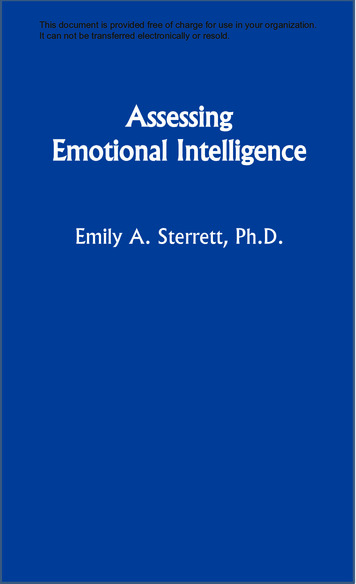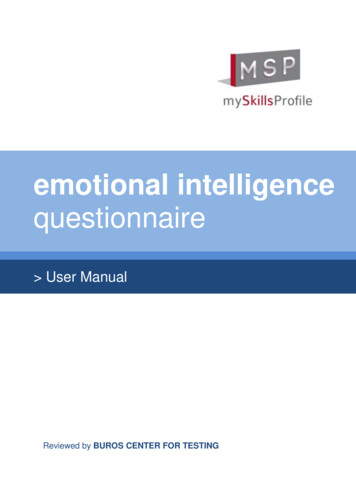
Transcription
emotional intelligencequestionnaire User ManualReviewed by BUROS CENTER FOR TESTING
2014, MySkillsProfile.com Limited.www.myskillsprofile.com.com.EIQ16 is a trademark of MySkillsProfile.com Limited.All rights reserved. No part of this publication may be reproduced or distributed in any form or by anymeans or stored in a database or retrieval system without the prior written permission ofMySkillsProfile.com Limited.
3EIQ16 User ManualContents1.0 INTRODUCTION .51.1 EIQ16 Questionnaire . 51.2 Concept Model . 51.3 Versions . 61.4 Access . 61.5 Design Criteria . 61.6 Development Overview . 61.7 EI Models. 71.8 EI Measures . 81.9 EIQ16 Emotional Intelligence Test . 112.0 ADMINISTRATION .162.1 Administered by Professional. 162.2 Direct Access . 162.3 Scoring and Norming . 163.0 SCALE DESCRIPTIONS .173.1 Scale Items . 173.2 Relationships with Other Scales . 173.3 Scale Contents . 174.0 INTERPRETATION AND FEEDBACK REPORT .354.1 Sten Scores . 354.2 Feedback Report . 365.0 RELIABILITY AND VALIDITY .375.1 Internal Consistency Reliabilities . 375.2 Correlations between Versions . 385.3 Scale Intercorrelations . 395.4 Intercorrelations and Reliability . 39myskillsprofile.com
4EIQ16 User Manual5.5 Standard Error of Difference . 395.6 Factor Analysis . 435.7 Relationship to Other Measures . 445.8 Correlations with Job Performance . 455.9 Demographics and EIQ16 scales . 495.10 Impression Management . 536.0 NORMS .547.0 REFERENCES .61myskillsprofile.com
5EIQ16 User Manual1.0IntroductionThis User Manual describes the administration, interpretation and technical properties of theEIQ16. It is available as a soft copy download only from myskillsprofile.com.1.1 EIQ16 QuestionnaireThe EIQ16 emotional intelligence questionnaire is designed to provide information about aperson’s emotional intelligence. The purpose of the instrument is to help people understandand develop emotional qualities, competencies and skills to improve their performance andreach their potential.1.2 Concept ModelThe EIQ16 questionnaire is based on the model of emotional intelligence developed byMayer, Salovey and Caruso (2002). This model of emotional intelligence has four keybranches which in the EIQ16 are named as follows: Reading People, Using Emotions,Understanding Emotions, and Managing Emotions.Figure 1. Mayer, Salovey and Caruso model of emotional gEmotionsManagingEmotionsReading people, according to Mayer at al, covers the ability to recognize emotions in oneselfand others as well as in objects, art, stories, music and other phenomena. Using emotions isthe ability to generate, use and feel emotion to communicate feelings and employ them inthinking and decision making. Understanding emotions means being able to appreciateemotional information and to realize how emotions combine and progress throughrelationship transitions. Managing emotions describes the ability to be open to feelings andto control them in oneself and others in order to advance personal understanding andgrowth.myskillsprofile.com
6EIQ16 User ManualThe EIQ16 is a behavioral style instrument whereas the Mayer-Salovey-Caruso EmotionalIntelligence Test is an ability-based test.1.3 VersionsThere are two versions of the questionnaire.EIQ16 normative questionnaire. The full normative questionnaire requires a test taker torate their emotional skills and competencies using a 5 point Likert scale ranging from“Strongly agree” to “Strongly disagree”. The test also has one scale measuring impressionmanagement. The questionnaire consists of 136 statements (8 items per scale) and mosttest takers complete the questions in about 20 minutes. Table 1 summarizes what the EIQ16questionnaire scales measure. More detailed descriptions of scale content are provided inChapter 3.EIQ16 app. The App version of the questionnaire is a short instrument measuring the 4 keybranches of emotional intelligence depicted in Figure 1. It also provides an indication ofimpression management. This short test has 36 items taken from the full questionnaire andtakes about 5 minutes to complete.1.4 AccessThe EIQ16 is designed to be used by psychologists, coaches and other HR professionalsbut can also be purchased direct by individual managers and professionals from the websitewww.myskillsprofile.com.1.5 Design CriteriaThe EIQ16 was designed to meet the key criteria in the EFPA Review Model for theDescription and Evaluation of Psychological Tests (Bartram, 2002). The EFPA ReviewModel was produced to support and encourage the process of harmonizing the reviewing oftests. It provides a standard set of criteria to assess the quality of modern psychometrictests. These cover the common areas of test review such as norms, reliability, and validity.1.6 Development OverviewThe development of the EIQ16 can be broken down into five phases.Phase 1. In the first phase of development we carried out a literature review and contentanalysis of models and measures of emotional intelligence and built a concept model basedon the four-branch ability model of EI.myskillsprofile.com
7EIQ16 User ManualPhase 2. In the beta phase, we created an inventory with emotional competency scales andan impression management scale in the style of a behavioral style assessment test. Wepiloted the inventory online, analyzed the reliability and validity, generated norms, andproduced a technical manual. The assessment was initially made available as a free test forseveral months before the first commercial version was launched in 2006.Phase 3. In the third phase of development, we collected more data, conducted furtheranalysis, and made incremental improvements to enhance the reliability of the scales andimprove the format and contents of the computer-generated feedback report. We updatedthe user manual in the second half of 2011 in preparation for a test review. We submitted theinstrument to the British Psychological Society (BPS) for review in the first half of 2012 andthe review was published in July 2012.Phase 4. In the fourth phase of development, we built a short 4 scale version of thequestionnaire which we published as a free app in 2013. The items for the app wereselected by carrying out a 4-factor forced extraction and selecting the items that loadedhighest on each factor. The free app can be downloaded from Google Play.Phase 5. In the fifth phase of development following the BPS review, we decided to lookagain at the factor structure of the instrument using a procedure researchers have utilized toremove response acquiescence. With response acquiescence removed, we found strongerevidence for a factor model more congruent with the original concept model. We revised theuser manual to reflect these findings and address other issues raised by the BPS review.The revised manual was published in October 2014 and submitted to the Buros Center forTesting for Review in 2015. The review is due to appear in The Twentieth MentalMeasurements Yearbook in 2017.The rest of this chapter describes the development process and rationale for the design ofthe assessment in more detail.1.7 EI ModelsThere are three distinct models/frameworks in the field of emotional intelligence (Cherniss,2010): an ability model, a competency model, and a personality trait model.Ability model. Mayer and Salovey are the leading exponents of the ability model. In their1990 article, Mayer and Salovey define EI as “a subset of social intelligence that involves theability to monitor one’s own and others feelings and emotions, to discriminate among themand to use this information to guide one’s thinking and actions”. Further work and reviews ofthe literature led the authors to divide EI skills and abilities into four areas covering the abilityto (a) perceive emotion, (b) use emotion to facilitate thought, (c) understand emotions, and(d) manage emotions. Mayer, Salovey, and Caruso (2004) state that EI is a member of aclass of “hot” intelligences dealing with personal and emotional cognitive processes.The Mayer-Salovey-Caruso Emotional Intelligence Test (MSCEIT) has eight scales with twomeasuring each of the four branches of EI. The Perceiving Emotions’ scales ask test takersto identify (a) emotions in faces, and (b) the emotions conveyed by landscapes and designs.The Using Emotions’ scales ask test takers to (a) compare emotions to other tactile andmyskillsprofile.com
8EIQ16 User Manualsensory stimuli, and (b) identify the emotions that facilitate different types of thinking. TheUnderstanding Emotions’ scales test a person’s understanding of (a) how emotions changein intensity and type and (b) how emotions can blend into complex emotional states. TheManaging Emotions’ scales ask test takers how they would manage (a) their own feelingsand emotions, and (b) other people’s feelings and emotions in different scenarios.Competency model. Daniel Goleman has been a leading exponent of the competencymodel and he has been largely responsible for popularizing the concept of EI in theworkplace. Goleman’s 1998 Harvard Business Review article entitled “What makes aleader?” applied the construct to business leadership. In his article, Goleman argued thatintelligence, toughness, determination, and vision were not enough to be successful. In orderto succeed in business, you also needed to possess a high degree of EI. Goleman identifiedfive groups of EI competencies: self-awareness, self-regulation, motivation, empathy, andsocial skill. Goleman’s Emotional Competence Framework published by the Consortium forResearch on Emotional Intelligence defines these competencies and their elements.Personality/trait model. The personality or trait model of emotional intelligence has beenled by Petrides and Furnham at the London Psychometric Laboratory. Using contentanalysis, Petrides and Furnham (2001) identified 15 facets of personality relevant to EIwhich formed the basis of their Trait Emotional Intelligence Questionnaire (TEIQue). Factoranalysis of the instrument indicates that trait EI covers 4 areas which in the TEIQue arelabeled as Well-Being, Self-Control, Emotionality, and Sociability. The TEIQue total scorecorrelates strongly with three of the Big Five personality factors (Conscientiousness,Extraversion, and Emotional Stability) and with the General Factor of Personality (GFP).According to Petrides et al (2007), trait EI (also defined as trait emotional self-efficacy)“refers to a constellation of emotional self-perceptions located at the lower levels ofpersonality hierarchies”.1.8 EI MeasuresTable 1 provides a summary of eight measures of emotional intelligence that have beenreviewed by the Consortium for Research on Emotional Intelligence in Organizations and forwhich there is “a substantial body of research” (defined as at least five published journalarticles or book chapters that provide empirical data based on the test).myskillsprofile.com
Table 1. Measures of emotional intelligenceEmotional QuotientInventoryEmotional and SocialCompetenceInventoryGenos EmotionalIntelligence InventoryMayer-SaloveyCaruso EI TestSchutte Self Report EITestTrait EmotionalIntelligenceQuestionnaireWork GroupEmotionalIntelligence ProfileWong's EmotionalIntelligence ScaleSelf-assessment360-degree feedback360-degree entSelf-assessmentSelf-assessmentHigher order factors/composite scalesSelf-awareness andself-expressionSelf-awarenessPerceiving emotionsWell-beingAbility to deal with ownemotionsSocial awareness ating thoughtSelf-controlAbility to deal withothers' emotionsEmotional managementand regulationSocial awarenessUnderstandingemotionsEmotionalityChange managementRelationshipmanagementManaging emotionsSociabilitySelf-motivationPrimary scales / subscalesAppraisal andexpression of emotionin the selfAppraisal andrecognition of emotionin othersSelf-regardEmotional awarenessEmotional selfawarenessFacesAppraisal andexpression of emotionAdaptabilityAbility to recognize ownemotionsEmotional selfawarenessAccurate selfassessmentEmotional expressionPicturesRegulation of emotionAssertivenessAbility to discuss ownemotionsAssertivenessSelf-confidenceEmotional awarenessof othersSensationsUtilization of emotionEmotion perception(self and others)Ability to manage ownemotionsRegulation of emotionin the selfIndependenceEmotional self-controlEmotional reasoningFacilitationEmotion expressionAbility to recognizeothers' emotionsUse of emotion tofacilitate performanceSelf-actualizationTransparencyEmotional selfmanagementBlendsEmotion management(others)Ability to manageothers' emotionsEmpathyAdaptabilityEmotional managementof othersChangesEmotion regulationSocial responsibilityAchievementEmotional self-controlEmotion itiativeEmotional relationsRelationships
10EIQ16 User ManualEmotional QuotientInventoryEmotional and SocialCompetenceInventoryStress toleranceOptimismSelf-esteemImpulse zationalawarenessSocial awarenessFlexibilityService orientationStress managementProblem-solvingDeveloping othersTrait empathyOptimismInspirational leadershipTrait happinessHappinessChange catalystTrait optimismInfluenceConflict managementTeamwork andcollaboration77myskillsprofile.comGenos EmotionalIntelligence InventoryMayer-SaloveyCaruso EI TestSchutte Self Report EITestTrait EmotionalIntelligenceQuestionnaireWork GroupEmotionalIntelligence ProfileWong's EmotionalIntelligence Scale
Table 1 indicates some overlap in what the tests measure as some of the same scale labelscan be seen in different tests even though the tests differ in whether they are measuringcompetencies, traits, or abilities. Nearly all the tests have at least some scales at the factoror facet level which can be linked to the descriptions of the four branches of emotionalintelligence provided by Mayer and Salovey. Five of the tests are designed to measureemotional competencies and workplace behaviors, two of the tests are designed to measuretrait EI, and one test is designed to measure cognitive abilities (Table 2).Table 2. Types of emotional intelligence assessment testCompetency ModelTrait ModelAbility ModelEmotional and SocialCompetence InventoryEmotional Quotient InventoryMayer-Salovey-Caruso EI TestGenos Emotional IntelligenceInventoryTrait Emotional IntelligenceQuestionnaireSchutte Self Report EI TestWork Group EmotionalIntelligence ProfileWong's Emotional IntelligenceScaleThere have been numerous studies of the factor structure of ability EI. Fan et al (2010)analyzed nineteen studies of the internal structure of the Mayer–Salovey–Caruso EmotionalIntelligence Test (MSCEIT) using a meta-analytic structural equation modeling approach.They showed that although the four-factor model of ability EI had excellent fits on fourdifferent indices, it was not preferred due to a high correlation between two branches. Onthis basis, the authors proposed that a three-factor solution (with branches one and twomerged as one factor) was the best-fitting alternative model of the MSCEIT structure.Studies of the internal structure of the Trait Emotional Intelligence Questionnaire providesupport for four trait EI factors (Petrides, 2011).The field of EI has not reached a position where a specific factor model (such as the Big Fivein personality) commands widespread support. Moreover, the factor models of ability EI andtrait EI are quite different because trait EI and ability EI are different constructs. It is also notfully understood how ability EI and trait EI influence competency EI although commonsensewould suggest that an individual’s cognitive abilities and personality traits will have an impacton the emotional skills and competencies they display.1.9 EIQ16 Emotional Intelligence TestThe design of the EIQ16 owes more to the ability and competency models of EI than traitmodels of EI. We adopted Mayer and Salovey’s four branch model of EI, and decided toconstruct a test of emotional intelligence measuring emotional skills and competenciesrather than cognitive abilities. In contrast to the MSCEIT ability measure, which asks testtakers to, for example, identify emotions in faces and landscapes, the EIQ16 takes the
12EIQ16 User Manualapproach of a behavioral style assessment test, and asks test takers how far they agree witha series of statements about their emotional skills and competencies.We embraced Mayer and Salovey’s framework because we wanted our measure to focus onemotional skills and abilities and not stray into the assessment of broader management andleadership competencies that are included in, for example, the Emotional and SocialCompetence Inventory and the Emotional Competence Framework. We also envisioned thatthe primary application of the instrument would be in development applications, and wewanted to create a relatively short measure that participants would take as part of executivelearning programs. This led us to utilize the format of a behavioral style self-assessment test(rather than an ability test or a 360-degree feedback survey).The EIQ16 concept model (Figure 2) has sixteen emotional competencies covering the fourbranches of emotional intelligence identified by Mayer and Salovey (four clusters of fouremotional competencies). These facets of emotional competence were identified byanalyzing the contents of existing models and measures, and the rationale for positioningparticular facets under particular branches is based in the main on content analysis oftheories and conceptual models of EI in the literature rather than empirical evidence.Table 3 provides concise descriptions of what each of the sixteen EIQ16 competency scalesmeasure.Reading people. The scales labeled Self-Analysis, Self-Expression, Analysis of Others, andDiscrimination are designed to measure some of the key abilities in the first branch of Mayerand Salovey’s ability model—that is, an individual’s ability to recognize and express theirown and other people’s feelings and emotions. There are scales in all the measures in Table2 that are designed to measure this branch of emotional intelligence. For example, theGenos Emotional Intelligence Inventory has three scales labeled Emotional Self-Awareness,Emotional Expression, and Emotional Awareness of Others. The TEIQue has two scaleslabeled Emotion Perception (Self and Others) and Emotion Expression.Using emotions. The scales labeled Thinking, Judgment, Sensitivity and Problem Solvingare designed to measure the abilities in the second branch of the ability model. Mayer andSalovey state that people who are able to integrate their feelings and emotions with othersources of information are more creative, flexible and adaptable in the way they tackleproblems and make decisions. In the Genos Emotional Intelligence Inventory, the relevantscale is called Emotional Reasoning, and in the Schutte Self Report EI Test, it is calledUtilization of Emotions.Understanding emotions. The scales labeled Symptoms, Causes, Complexity, andTransitions are designed to measure the third branch of the ability model. Mayer andSalovey define this branch as the “capacity to analyze emotions, appreciate their probabletrends over time, and understand their outcomes.” This area of emotional intelligenceappears to be under-represented in many of the measures of EI in Table 2.myskillsprofile.com
13EIQ16 User ManualTable 3. What the scales measureAnalysis of othersThe extent to which you pay attention to and identify other people’sfeelings and emotions.Self-expressionHow far you are able to describe and communicate your feelings andemotions.DiscriminationHow far you pick up on emotional cues and can tell when something iswrong or when someone is trying to deceive you.ThinkingThe degree to which you follow your hunches and feelings and let yourfeelings guide your thinking.JudgmentThe extent to which you allow your instincts and intuition to influenceyour judgments and decisions.SensitivityThe extent to which you are able to capitalize on mood changes in apositive way to explore and analyze things.Problem solvingThe extent to which you use your own and other people’s feelings andemotions to help solve problems.SymptomsYour ability to recognize a range of common emotions – for example,happiness, anger, fear, surprise, interest etc.CausesHow far you understand the factors that lead people to experiencedifferent feelings and emotions.ComplexityThe extent to which you understand complex feelings, emotional blendsand contradictory states.TransitionsThe degree to which you are aware of and can anticipate how emotionsprogress and change.OpennessThe extent to which you stay open to pleasant and unpleasant feelingsto help manage situations and events.MonitoringHow far you are able to reflectively engage or ignore your feelings andemotions to help guide your actions.Self-controlYour ability to stay in control of your feelings and emotions when youare under pressure and stress.Managing othersThe degree to which you are able to manage other people’s feelings andemotions in a sympathetic manner.myskillsprofile.comManaging emotionsThe degree to which you are in touch with your feelings and emotionsand notice when your mood changes.Understanding emotionsSelf-analysisUsing emotionsWhat the scale measuresReading peopleScale
14EIQ16 User ManualManaging emotions. The scales labeled Openness, Monitoring, Self-Control, andManaging Others are designed to measure some of the key skills in the fourth branch of theability model. Mayer and Salovey state that emotionally intelligent individuals are adept atregulating emotion in themselves and others. They are able to enhance their own and otherpeople’s moods in order to help achieve particular outcomes—for example, motivating teammembers to achieve team goals. This area of EI features strongly in the eight EI measures inTable 1.Impression management. In addition to the competency scales, the EIQ16 has animpression management scale to throw light on response bias, a common issue withnormative assessments. The core items for the IM scale were drawn from the InternationalPersonality Item Pool (Goldberg, 1997).Each of the EIQ16 scales has eight items. Four items are keyed positively and four keyednegatively. Test takers are required to say how far they agree with each item using a fivepoint Likert scale.KeyExample Item I try to understand the reasons for people’s feelings-I don’t pick up on emotional cuesmyskillsprofile.com
Figure 2. EIQ16 concept model of emotional intelligenceEIReading peopleUsing nalysisThinkingSymptomsOpennessAnalysis of tivityComplexitySelf-controlDiscriminationProblem solvingTransitionsManaging others
2.0 AdministrationThe EIQ16 is administered online via the Internet. There are two ways that persons can betested.2.1 Administered by ProfessionalWhere the test is being administered to a group of people by a psychologist or coach, thetest taker receives an email from the test administrator containing a hyperlink which takesthe test taker to a testing screen with instructions on how to complete the test. The test takerthen goes through a series of screens with the questions and completes a personal detailsform.Once the assessment test has been completed, the client may view or download thecomputer-generated feedback report if the online testing service has been set up to providefeedback reports to test takers. The online testing system can be set up by a testadministrator to have feedback reports emailed to the test administrator, or to the test taker,or to the test taker and to the test administrator.2.2 Direct AccessIndividuals can also purchase the EIQ16 assessment test direct from myskillsprofile.com.In this instance, the test taker is presented with instructions about how to complete the test,does the test and then completes a personal details form. The individual then pays for theassessment by credit card and once the transaction has been processed, the test taker canview and download the feedback report in PDF format. Test takers can also request a copyof their feedback report to be emailed to them.2.3 Scoring and NormingThe scoring and generation of feedback reports are done online. A person’s EIQ16 rawscores are compared to a very large international comparison group of people who haveanswered the questionnaire. Details of this norm group are given in Chapter 6.
17EIQ16 User Manual3.0 Scale DescriptionsEach scale description table in this chapter contains elements covering the meaning of lowscores, moderate scores and high scores.3.1 Scale ItemsThe EIQ16 questionnaire has 8 items per scale with equal numbers of positively andnegatively keyed items. The tables below present examples of the items.3.2 Relationships with Other ScalesThe final section of each table shows other scales that the scale correlates highly with.These correlations are from the international comparison group. The full intercorrelationmatrix is shown in Table 6 in Chapter 5.3.3 Scale ContentsScalePageSelf-analysis18Analysis of 2Judgment23Sensitivity24Problem 29Openness30Monitoring31Self-control32Managing others33Impression management34myskillsprofile.com
18EIQ16 User ManualKey Area 1. Reading PeopleScale 1.1. Self-analysisHigh scorersDescriptionAre in touch with their feelings and emotions and notice when their mood changes.Example positive itemI notice when my mood changes.Moderate scorersDescriptionAre moderately aware of their feelings and emotions.OrAre aware of how they are feeling some of the time.Low scorersDescriptionPay little attention to their feelings and emotions.Example negative itemI rarely stop to analyze how I'm feeling.Correlations with other scalesROpennessSelf-expressionTransitionsProblem solving0.660.620.620.61myskillsprofile.com
19EIQ16 User ManualKey Area 1. Reading PeopleScale 1.2. Analysis of othersHigh scorersDescriptionPay close attention to and identify other people’s feelings and emotions.Example positive itemI am good at sensing what others are feeling.Moderate scorersDescriptionPay some attention to other people’s feelings and emotions.OrPay attention to and identify other people’s feelings and emotions in some situationsbut not others.Low scorersDescriptionPay very little attention to and do not tend to identify other people’s feelings andemotions.Example negative itemI am indifferent to the feelings of others.Correlations with other scalesROpennessTransitionsComplexityManaging others0.650.640.640.63myskillsprofile.com
20EIQ16 User ManualKey Area 1. Reading PeopleScale 1.3. Self-expressionHigh scorersDescriptionAre skilled at describing and communicating their feelings and emotions.Example positive itemI am able to describe my feelings easily.Moderate scorersDescriptionAre moderately skilled a
social skill. Goleman’s Emotional Competence Framework published by the Consortium for Research on Emotional Intelligence defines these competencies and their elements. Personality/trait model. The personality or trait model of emotional intelligence has been led by Petrides and Fur


